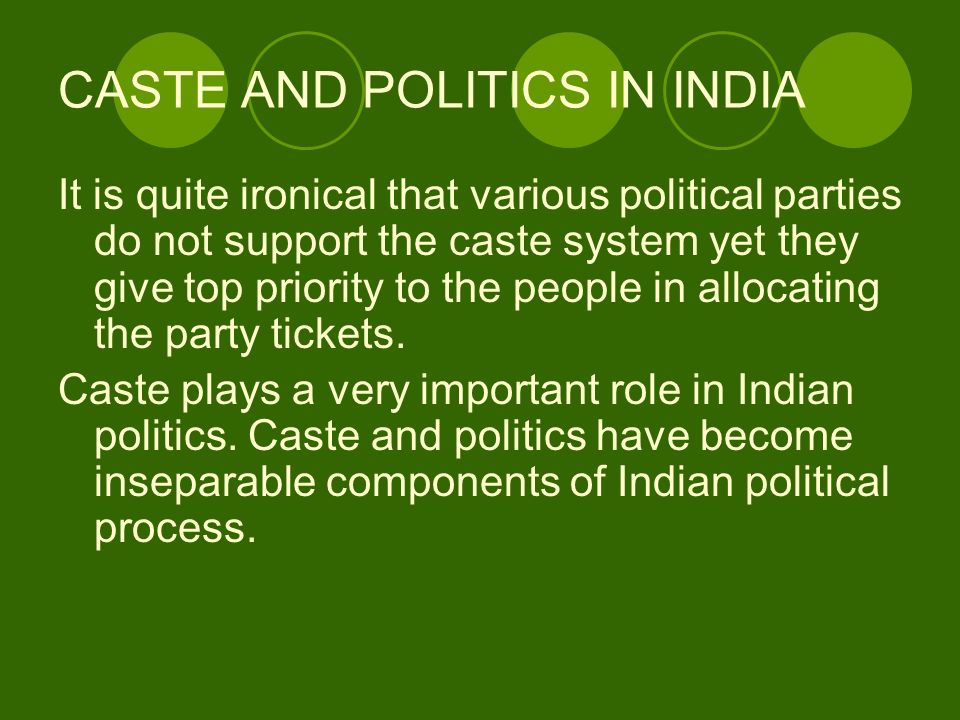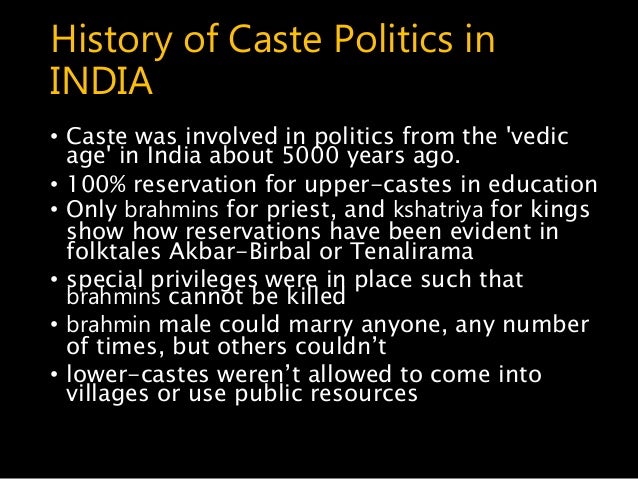Relevance: Sociology: Politics and society; Caste Perspectives; caste conflicts
Emergence of electoral democracy in India created a very fertile ground. Caste system is a closed system but it’s still evolving. British saw caste as a prism to understand India’s social reality- “White man’s burden”.
Caste became a tool for justifying their rule in India. It led to caste conflicts among people. Caste also started churning in social consciousness. Therefore caste started evolving in Indian society.
Modern Constitution abolished untouchability , also in 1976 (the Protection of Civil Rights Act), reservation of seats which ultimately resulted in further concretisation of caste.
Caste and casteism never disappeared in India. Myron Weiner’s concept of “political co-optation” became very relevant. The policy of political mobilization followed by Congress and other parties also resulted in co-optation many lower castes into the party.
With the erosion of the moral basis of caste, the self-imposed barrier to protest by the lower castes was also eroded. Therefore some middle and lower castes sought equality with the upper castes through the process of sanskritisation (by emulating the orthopraxy of the higher castes), thus claiming more political power.

Thus according to Rajni Kothari, politicisation of caste in India played a very important role in developing party politics. He proved how politicisation of caste is a double process.
Caste needs politics as much as politics need caste. When caste groupings makes politics their sphere of activities. Caste groups then also gets a chance to assert their identity and to strive for position.
MN Srinivas also used the concept of dominant caste. A dominant caste is a caste which dominates numerically , due to its numeric preponderance it enjoys political power.
Politicians find caste a handy and convenient instrument for use during elections. Politics in Indian states had also been viewed in terms of competition among major caste groups for political power. Caste is also said to fractionalize national politics.
The previously excluded political leaders now enter the sphere. Srinivas also talked about ‘dominant caste’ which gained political and economic power through sanskritisation.

Thus the intermediate castes also aspire for dominant position in every sphere due to the development of adult franchise and Panchayati Raj System. Although it is true that caste system had been strengthened rather than weakened by all these.
Caste based reservations came with the Article 15 of the Indian Constitution which prohibits discrimination of Indians on basis of religion, race , caste, sex or place of birth.
But Article 15 (4) modified by asserting that nothing in this article shall prevent the state from making any special provision for the advancement of any socially and educationally backward of citizens or for the SC’s and ST’s.
Thus the constitution simultaneously embodies two conflicting notions of equality, one bases on individual rights and the other based on group rights.
Also the Mandal Commission, or the Socially and Educationally Backward Classes Commission(SEBC), was established in 1979 by the Janata Party government under Prime minister Morarji Desai with a mandate to “identify the socially or educationally backward classes” of India.
It basically defined backward classes in terms of caste . The caste membership rather than individual class characteristics became the matter of importance. Thus low social ranking in the class rather than average per capita income became the criteria for inclusion in the OBC list.
Thus it made possible for caste membership to become responsible for identifying class benefits, thus social ranking became a matter of perception rather than a average per capita income.
Thus caste and class became cross cutting identities.
Also with time as stated by Christophe Jaffrelot , class started transforming caste relations in India. Thus class and caste started coexisting in Indian society.
Caste in India, thus slowly got converted into class plus status (social stigma of being pure and impure). Reservation helped certain jatis within dalits to catch up with OBC’s and other dominant castes in terms of acquiring revenues. Thus within caste group due to reservation , people started leaving their jobs thus creating a socio economic differentiation within their caste groups.
Thus caste continues to be a ‘lived in social reality’ as stated by Myron Weiner. Orthopraxy still continued although ideological basis of caste is undermined .
Still caste became an instrument of social change which resulted in rise of ‘casteism’, there also happened co-optation of previously excluded groups and this political mobilisation gave rise to ‘messy identity politics’.
Thus sharpening of group identities, also the scheme of reservations ‘taken hold as a mantra’( Marc Galanter) facilitated the lower caste groups to rise to political power.
The relation between class and caste is complex and ‘cross cutting ‘ (Myron Weiner), overlapping identities so the struggle for status and the quest for equality continued.
So caste became a far more potent form of social identity than class so social order remained inegalitarian. Also Mandal framework led ‘egregious consequences’ (Marc Galanter) because it identified Other Backward Classes in terms of caste .
It created a heterogeneous vast diverse category of OBC’s. Thus caste became the basis of a scheme of permanent protection.
‘Curious Cognitive hiatus’ as stated by Rajni Kothari, which explained the dichotomy between tradition and modernity ,also the symbolism of caste for social and economic positions of different groups.
Thus caste as a traditional social structure has changed its functions and roles, maintaining itself in the process. Thus like caste has been changing and influencing politics, politics has also been influencing and changing the caste system.
Sanskritisation as status urge turned as a ‘mirage’ (Kothari) , status became ambivalent, unsettled also Westernisation and secularisation led for economic well being, liberal education gave rise to rationality and also political power for more institutions drew caste into politics.
Thus caste identities took to new form of articulation thus changing the very ethics of the social system and diminished the very importance of ascriptive and ritualistic basis on the other hand the process of ‘ethnicization’ and positive discrimination of caste has been the result of transformation of caste into interest groups.

